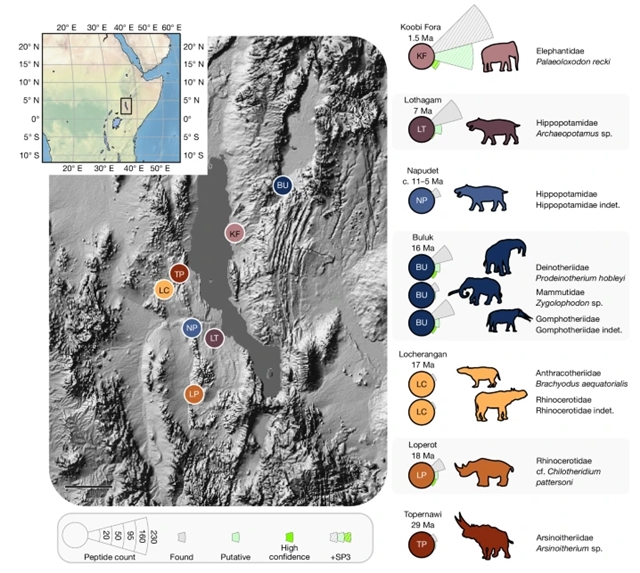
近日,美国博物馆保护研究所Timothy P. Cleland团队研究了来自东非裂谷的1800万年的珐琅蛋白质组。相关论文于2025年7月9日发表在《自然》杂志上。
通过古DNA和蛋白质组学对已灭绝分类群的古生物学研究大多局限于上新世-更新世化石,这是由于分子随着时间的推移而分解,而在热带环境中这种分解加剧了。
研究组从肯尼亚图尔卡纳盆地从更新世到渐新世的古生物遗址的化石的内部珐琅质中取样了小的蛋白质组,这为新生代哺乳动物的进化提供了丰富的记录。通过基于质谱技术的蛋白质组学工作流程,并采用定位牙釉质来源成岩蚀变产物的筛选标准,研究组从布卢克遗址(距今1600万年)和洛佩罗特遗址(距今1800万年)采集的早中新世犀科动物及多种长鼻类动物样本中,成功提取出釉原蛋白、成釉蛋白、基质金属蛋白酶-20以及牙本质基质酸性磷蛋白1的片段。成岩样数量在逐渐变老的化石中下降,研究组观察到不同地点中新世早期保存的差异。
系统发育分析揭示了这些序列对灭绝分类群系统定位的贡献,尽管研究组警告说,这种方法可能会考虑到稀疏的片段、片段识别的不确定性和可能的序列成岩作用。研究组确定了可能支持这些蛋白质古老年龄的修饰,以及一些已知的最古老的晚期糖基化终产物的例子。在地球上持续最温暖的地区之一的致密牙釉质组织中发现蛋白质序列,有望发现更古老的蛋白质组,这将有助于研究古生物学和灭绝分类群的进化关系。
附:英文原文
Title: Eighteen million years of diverse enamel proteomes from the East African Rift
Author: Green, Daniel R., Uno, Kevin T., Miller, Ellen R., Feibel, Craig S., Aoron, Eipa Emmanuel, Beck, Catherine C., Grossman, Aryeh, Kirera, Francis M., Kirinya, Martin M., Leakey, Louise N., Liutkus-Pierce, Cynthia, Manthi, Fredrick K., Ndiema, Emmanuel K., Nengo, Isaiah O., Nyete, Cyprian, Rowan, John, Russo, Gabrielle A., Sanders, William J., Smiley, Tara M., Princehouse, Patricia, Vitek, Natasha S., Cleland, Timothy P.
Issue&Volume: 2025-07-09
Abstract: Research into the palaeobiology of extinct taxa through ancient DNA and proteomics has been mostly limited to Plio-Pleistocene fossils1,2,3,4,5,6,7,8,9, due to molecular breakdown over time, which is exacerbated in tropical settings1,2,3. Here we sample small proteomes from the interior enamel of fossils at palaeontological sites from the Pleistocene to the Oligocene in the Turkana Basin, Kenya, which has produced a rich record of Cenozoic mammalian evolution10. Through a mass-spectrometry-based proteomic workflow, and using criteria to locate diagenetiforms derived from enamel, we recover fragments of enamelin, ameloblastin, matrix metalloprotease-20 and dentin matrix acidic phosphoprotein1 from an Early Miocene rhinocerotid and several proboscideans collected from the sites of Buluk (16million years ago; Ma) and Loperot (18Ma). Diagenetiform counts decline in progressively older fossils, and we observe variability in Early Miocene preservation across sites. Phylogenetic analyses reveal the contribution of these sequences to the systematic placement of extinct taxa, although we caution that this approach must account for sparse fragments, uncertainty in fragment identification and possible sequence diagenesis. We identify likely modifications that support the ancient age of these proteins, and some of the oldest examples of advanced glycation end-products yet known. The discovery of protein sequences within dense enamel tissues in one of the persistently warmest regions on Earth promises the discovery of much older proteomes that will aid in the study of the palaeobiology and evolutionary relationships of extinct taxa.
DOI: 10.1038/s41586-025-09040-9
Source: https://www.nature.com/articles/s41586-025-09040-9
Nature:《自然》,创刊于1869年。隶属于施普林格·自然出版集团,最新IF:69.504
官方网址:http://www.nature.com/
投稿链接:http://www.nature.com/authors/submit_manuscript.html
